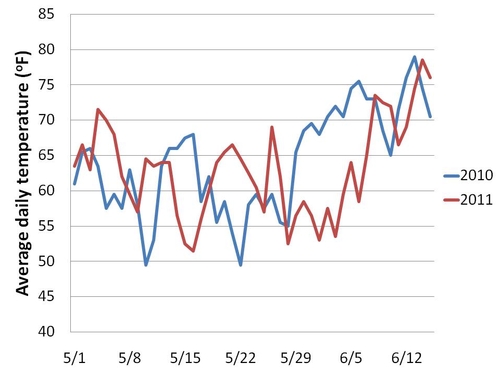- Author: Luis Espino
Here's the beginning of the 2011 rice season in three graphs*:
Degree day (DD) accumulation over the developmental threshold of 55 oF (starting May 1st) during early May in 2011 was similar to 2008 and 2009. By mid May, temperatures dropped drastically and DD accumulation for 2011 now resembles more 2010, a cool year. Rice planted early to mid May is behind.

During 2011, there were not enough heat units during mid May and early June (no DD). In comparison, during 2008, heat unit accumulation was high during mid May and increased gradually from the end of May to early June.

Average daily temperatures during early May 2011 were higher than during 2010. However, the trend didn't last long and temperatures dropped in mid May. During late May and early June 2011 temperatures were substantially lower than during the same period in 2010.

What's coming next? Hard to say, but we seem to be facing another unusual year that looks much like 2010.
*All temperatures used are from the CIMIS station #32 at Colusa.
- Author: Luis Espino
The last couple of weeks we had some unusually cold weather. Some days, daytime temperature was 20 degrees below the average for this time of the year. The graph below compares average maximum daily temperatures with actual 2011 maximum daily temperatures during April and May in Colusa County. 
Because of the cold weather, rice seedlings aren't growing much. Growth is very slow, and plants seem to lag behind. However, don't think that just because the rice is not growing, other organisms are also slowed down. I've been hearing of shrimp in several fields, and saw some in a field that was planted two weeks ago. Look at the size of the shrimp and the size of the seedlings in the pictures below.


Tadpole shrimp can grow very fast. A few days with water temperatures between 60 and 84 can promote egg germination and shrimp development. Since the rice is growing slower than normal because of the cold weather, it is under more risk of being injured by shrimp. Monitor your field closely during seedling development, and worry about shrimp only until the rice breaks the water surface. Once the rice is out of the water, shrimp will not cause damage. A lengthy discussion of the biology of the tadpole shrimp was included in the May issue of the Rice Briefs newsletter, available at the Colusa County Rice Program website: http://ucanr.org/sites/colusa/rice/Newsletter/
For monitoring and treatment recommendations, go to the UC IPM website: http://www.ipm.ucdavis.edu/PMG/selectnewpest.rice.html
- Author: Luis Espino
Released May 23, 2011, by the National Agricultural Statistics Service, Agricultural Statistics Board, United States Department of Agriculture

- Author: Luis Espino
Released May 16, 2011, by the National Agricultural Statistics Service, Agricultural Statistics Board, United States Department of Agriculture

- Author: Luis Espino
Released May 9, 2011, by the National Agricultural Statistics Service, Agricultural Statistics Board, United States Department of Agriculture




